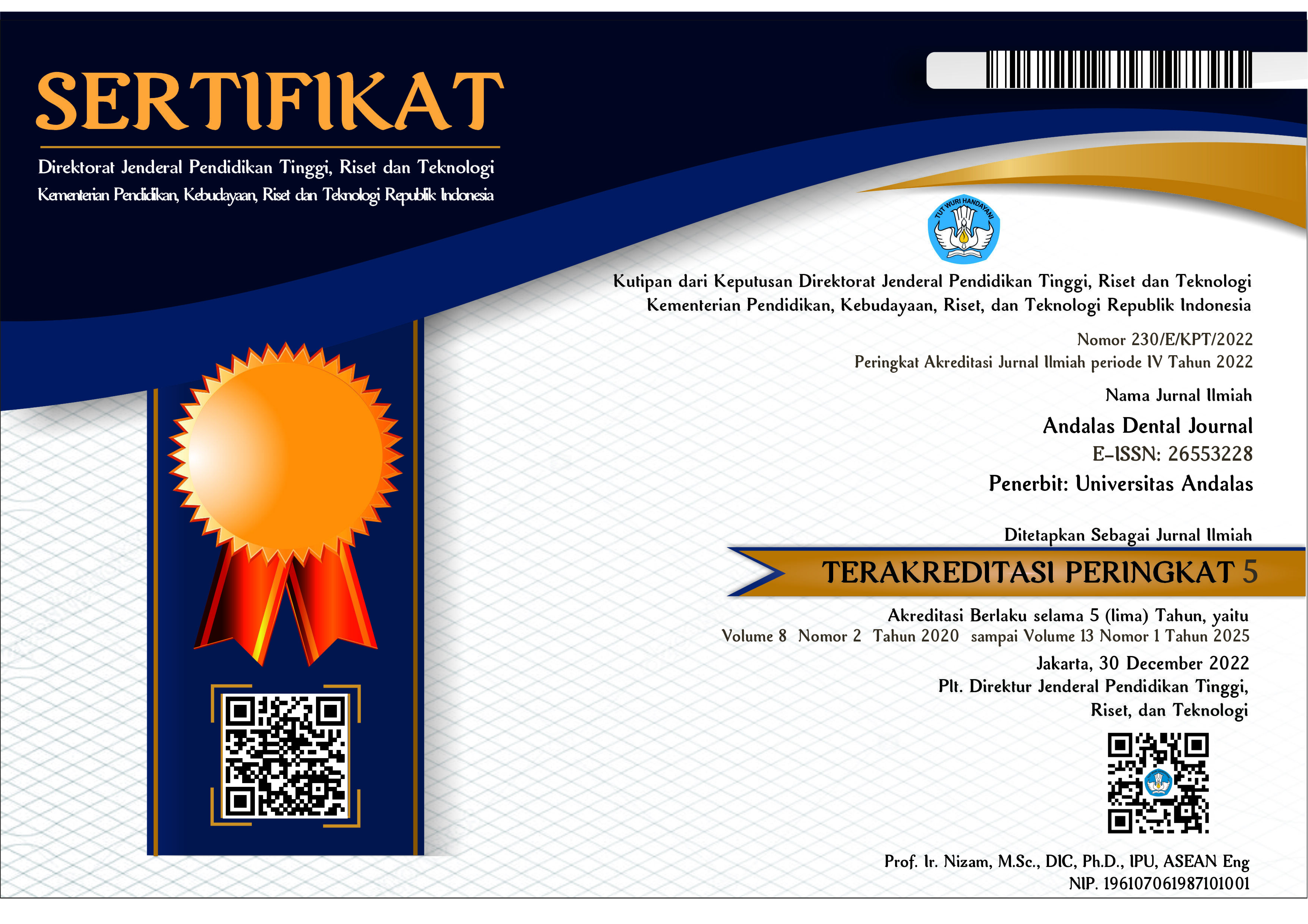Uji Daya Hambat Ekstrak Kulit Langsat (Lansium parasiticum) Terhadap Pertumbuhan Bakteri Enterococcus faecalis Secara In Vitro
Abstract
Enterococcus faecalis is a bacteria that commonly found in secondary root canal infections. Enterococcus faecalis is a gram-positive, facultative anaerobic bacteria. Langsat (Lansium parasiticum) is a natural ingredient that contains secondary metabolites and has antibacterial ativity. The aim of this study was to examine the inhibition effect of langsat fruit peel extract (Lansium parasiticum) to the growth of Enterococcus faecalis. This was a laboratory experimental study with post-only control group design. Langsat fruit peel extract with 25%, 50%, 75%, and 100% concentration was using disc diffusion method on Mueller-Hinton Agar (MHA) and the inhibition zone was measured with a sliding caliper. The data were analyzed with Kruskal-Wallis test and Mann-Whithney test. The result of this study was langsat fruit peel extract with 25%, 50%, 75% concentration showed a inhibition zone, while at 100% showed no inhibition zone. The Kruskal-Wallis test showed that there are significant differences (p <0.05) between all groups. The conclusion was langsat fruit peel extract (Lansium parasiticum) have weak inhibition effect of the growth of Enterococcus faecalis bacteria. The inhibition zone of concentrations 25% : 2,20 mm; 50%: 0,94 mm; 75%: 0,36 mm and 100% : 0,00 mm.
References
2. Rhodes JS. Advanced Endodontics Clinical Retreatment and Surgery, Taylor & Francis Group, London; 2006.
3. Walton ER, Torabinajed M, Prinsip dan Praktek Ilmu Endodonsia edk. 3, trans, Dr. Narlan Sumawinata, drg.,SpKG(K), Lilian Juwono, EGC, Jakarta; 2008.
4. Grossman LI, Oliet S, Del Rio CE. Ilmu Endodontik dalam Praktek (terj), ed. 11, Penerbit Buku Kedokteran EGC, Jakarta; 1995.
5. Tanumihardja M. Larutan Irigasi Saluran Akar, Dentofasial. 2010; 9: 108-115.
6. Zehnder M, Root canals irrigants. J Endod. 2006; 32: 389-98.
7. Wardhana DF, Rukmo M, Budi AT. Daya Antibakteri kombinasi metronidazol, siprofloksasin dan minosiklin terhadap Enterococcus faecalis, Jurnal Ilmu Konservasi Gigi Unair. 2008; 1(1): 23-28.
8. Garg N, Garg A. Textbook of endodontics, 2nd ed, Jaypee Brothers Medical Publishers, New Delhi; 2010.
9. Poedjarwoto T, Cyrus H, Nrindh P. Daya Antimikroba Obat Tradisional Diare terhadap Beberapa Jenis Bakteri Enteropatogen, Jurnal Cermin Dunia Kedokteran. 1992; 76: 67.
10. Tilaar M, et al. Review of Lansium domesticum Correa and its use in cosmetic. BLACPMA. 2008; 7: 183-189.
11. Ragasa CY, Labrador P, Rideout JA. Antimicrobial Terpenoids from Lansium domesticum. Philipp Agric Sci. 2006; 89: 101-105.
Copyright (c) 2020 Andhini Ardi, Dedi Sumantri, Surma Adnan

This work is licensed under a Creative Commons Attribution-ShareAlike 4.0 International License.















